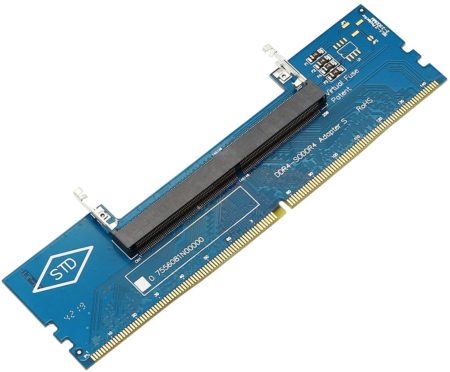Yes, you can use laptop ram on a desktop as long as the ram is compatible with the desktop’s specifications. Laptops and desktops use different types of ram, with laptops typically using smaller SODIMM modules and desktops using larger dimm modules.

However, some desktop motherboards have slots compatible with both types of ram, allowing you to use laptop ram on a desktop. Before attempting to use laptop ram on a desktop, it is essential to check the specifications of your motherboard and ensure that it supports the type and speed of the ram you plan to install.
You should also consider the capacity and compatibility of the existing ram modules on your desktop to avoid any compatibility issues.

Credit: pcguide101.com
Table of Contents
Understanding The Basics Of Ram
Ram, or random access memory, is an essential computer system component. It plays a crucial role in storing and providing quick access to data that the computer needs to execute tasks. Different types of ram are available, such as DDR, ddr2, ddr3, and ddr4, each with its specifications.
These specifications include capacity, speed, and latency, which determine the performance of the ram module. Now, using laptop ram on a desktop is generally not recommended. Laptop ram is physically different in size and shape compared to desktop ram, and they are incompatible.
Therefore, it is essential to use the appropriate type of ram that is specifically designed for the computer system you are using.
Comparing Laptop Ram And Desktop Ram
Laptop and desktop ram have physical differences in form factor and pin configuration, affecting compatibility. The primary distinctions are the form factor, pin configuration, and voltage requirements. Laptop ram modules have a smaller form factor and fewer pins than desktop ram.
Each ram type requires different voltage levels to function correctly in their respective devices. Trying to use laptop ram on a desktop may lead to compatibility issues due to the differences in form factor, pin configuration, and voltage requirements. Considering these factors when upgrading or replacing the ram in your computer is crucial to ensure seamless compatibility and optimal performance.
Compatibility Factors To Consider
Matching the ram type and generation with the motherboard is crucial to ensure compatibility. It is essential to check the motherboard’s maximum supported ram capacity. This will ensure that the desired laptop ram can be used on the desktop. Additionally, ensuring that the voltage requirements of the ram and motherboard align is necessary.
This will prevent any potential damage or performance issues. Considering these compatibility factors, users can successfully use laptop ram on their desktops, enhancing the system’s performance without any compatibility issues. Whether upgrading or building a new desktop, these steps should be followed to ensure a smooth and error-free experience.
So, carefully match the ram type, generation, and voltage requirements with the motherboard to avoid undesired complications.
Checking Compatibility With Your Desktop
Checking the compatibility of laptop ram with your desktop is crucial. Identify the existing ram in your desktop by accessing the motherboard specifications and manual. Additionally, consult the manufacturer’s website or support for compatibility information. This will ensure that the laptop ram you intend to use is compatible with your desktop.
Avoid any potential issues that may arise from mismatched or incompatible ram. Compatibility is critical in maximizing the performance and efficiency of your desktop. Take the time to research and verify the specifications of your desktop before making any changes to the ram configuration.
With the correct information and assurance, you can confidently upgrade or replace your desktop’s ram using laptop ram without any compatibility concerns.
Potential Benefits And Limitations
Using laptop ram in a desktop system has potential benefits and limitations. One advantage is compatibility. Laptop ram can often be physically compatible with desktops. However, performance implications and potential bottlenecks may arise. The slower speed of laptop ram compared to desktop ram can impact overall system performance.
Additionally, overclocking considerations should be taken into account when using mismatched ram. Ensuring the system can handle the increased power demands and heat generated by overclocking is essential. In conclusion, while using laptop ram on a desktop is possible, weighing the advantages and limitations before deciding is critical.
Installing Laptop Ram In A Desktop
Installing laptop ram on a desktop requires specific steps to ensure a safe and successful process. First, configure the system to recognize the new ram properly. This can involve updating the bios or adjusting settings in the operating system.
Secondly, follow the manufacturer’s guidelines for installation, which usually involve opening the desktop case, locating the ram slots, and inserting the modules firmly. Handling the ram carefully is essential, avoiding static electricity and ensuring compatibility with the desktop’s motherboard.
Lastly, if any issues arise during installation, troubleshooting can be done by checking for loose connections, testing the ram modules individually, or seeking assistance from technical support. Following these steps, you can effectively use a laptop ram on a desktop, enhancing its performance and memory capacity.
Upgrading Desktop Ram Vs. Buying New
Are you upgrading your desktop ram or purchasing new ram for your laptop? Consider these factors: cost-effectiveness and performance gains. With a ram upgrade, you can boost your desktop’s speed and multitasking capabilities. On the other hand, buying new ram grants you future-proofing and flexibility, allowing for potential upgrades in the future.
It’s essential to weigh the pros and cons based on your specific needs and budget. Are you looking for an immediate improvement or a long-term investment? Ultimately, the decision lies in your hands. So, whether you maximize your existing desktop ram or invest in a new one, consider the cost-effectiveness, performance gains, future-proofing, and flexibility.
Your desktop’s performance and your wallet will thank you.
Frequently Asked Questions For Can I Use Laptop Ram In Desktop
Can I Use Laptop Ram In A Desktop?
Yes, you can use laptop ram on a desktop, but it’s crucial to consider compatibility. The laptop ram is smaller and designed specifically for laptops, so it may not fit or work correctly in a desktop motherboard. Check your desktop’s specifications and consult the manufacturer’s guidelines before making any changes.
Conclusion
Overall, it is possible to use laptop ram on a desktop, but it is essential to consider the compatibility issues and limitations that may arise. While laptop ram modules share a similar ddr type with the desktop ram, differences in physical size, such as form factor and pin configuration, can pose challenges.
Additionally, laptops often use lower-voltage ram modules, which may not be compatible with the higher voltage requirements of desktop motherboards. Furthermore, desktops have varying ram slot capacities, so it is essential to ensure that the laptop ram modules are compatible with the desktop motherboard’s specifications.
Upgrading ram in a desktop can improve performance, but it is crucial to carefully research and consult the motherboard’s documentation to ensure compatibility. Ultimately, consulting with an expert or referring to the manufacturer’s guidelines will provide the best solution for using laptop ram in a desktop.





